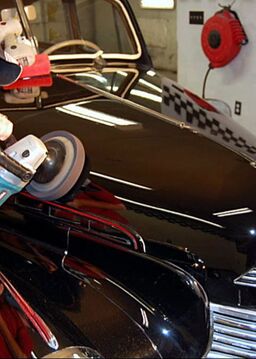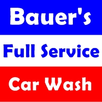 Usually when we talk about the wax, sealant, polish subject for your vehicle - this is one of the most misunderstood subjects for car enthusiasts and owners. You have no doubt heard many definitions being thrown around - waxes, sealants, glazes, paints, compounds using various means of hand or machines - rotary classified orbital dual action (machine polishers and buffers), and so on. It can be confusing, because of the number of products available on the market today - they seem to each use their own definition (non-standard) which really confuses the typical consumer if you do not know what you are looking for. Let's see if we can simplify this for you. First off, we'll start by focusing on using only hand processes and why you should use them. By doing so, what is the effect on the paint of your car and how does it help your vehicle? First let's go over a couple of terms: what is the difference between them. Wax and Sealant - When you see this, it usually indicates a coating layer on top of your paint to protect and beautify it. The word "wax" is used to this day as before it was really pure "candle wax" used for protection. "Sealant", used similarly to wax, is usually used to classify "synthetic waxes". Polish - When you see the word "polish", it basically means that the product is usually abrasive in nature. It is used to scrape a few layers of paint you want to smooth out or clean or even remove scratches. Abrasiveness may be in the form of a "mechanical" (the product has some grit to it) or "chemistry" (it chemically reacts with the surface) - but the end effect is the essentially the same. Cleaner wax / sealant - you may or may not understand this one - but when you see the word "clean" - the product is basically sitting in between wax and polish. It will typically have a small level of abrasiveness to clean and protect at the same time. Think of it as a mix of Polish and Wax together. Coating - This is a new category in protection. It has become popular today because it seems many folks like to do it when they have a new car. So what is it really ?? You could think of it as a chemical reaction with the surface, basically trying to create the same function - only supposed to last longer - as wax. It creates a slippery surface on your paint helping to protect the paint and not allow dirt and grime to stick to the surface. Some FAQs:
It's hard to beat a professional hand wax job! You get what you pay for, right? Well, that isn't always true, but here at Bauer's we strive to give you the very best care for what you pay. There is always an optimal level in terms of value for money. The beautiful shine often comes from the paint surface preparation, before wax is applied to it. This is another topic for another time - "swirl-free", "orange peel", "wet sanding" comes into play. But ultimately if your car is cleaned properly and the surface prepared, then a good quality wax and a skilled technician will produce some amazing results. Do you need a machine for waxing? – you can buy a orbital machine to ease the job, and a machine can help for stubborn spots. But as we stated above, a great hand wax produces a great result. How to make the wax last longer? – What is of the utmost importance is the cleaning process. Without proper cleaning, the wax you put on basically sticks to the dirt instead of the paint. This also bring us to "claying" whereby you remove contaminant from the surface. Unlike polish, it won’t correct the surface but only has minimal abrasiveness. It is similar to the effect of “cleaner wax”, but does a great job at smoothing the surface. Do you need to polish? – Yes, occasionally, because when you drive, you induce scratches no matter how careful you are. When you wash, it is the same. Eventually you will need to polish your car for it to look its best. For hard spots like stains, bugs and so forth – use a good cleaner wax. A tar remover is also handy to do some heavy cleaning or for light scratch removal. Do you need a machine? – For minor scratches or routine maintenance or cleaning of stains – no. Basically, a machine is required to accelerate the overall process. You can do the same by hand, it just takes longer. If you have the time, its hard to match the detail hand waxing can do. However for serious correction like removing swirls or heavy scratches – a machine is a must. In summary, here is the correct sequence: 1. Do a correct wash, clean properly and frequently – feel the paint. Is it smooth? 2. If not, then probably you need to clay it. If you don’t have a clay, then you should use a good cleaner wax after drying. 3. After wash, dry the car properly (minimize water marks). 4. If you want to polish, this is time for you to clean the contaminants, correct the scratches and so forth using hand or machine. 5. After all the correction, it is time to wax, coat, seal. Take note though, one of the most common mistakes people make is to use too much product during waxing. This creates a difficult buffing process, especially by hand. Use moderately and you can save some muscle! You don’t need a machine if performed properly. 6. Buff off everything from the surface. Feel the paint, it should be buttery smooth. Of course, here at Bauer's we offer a variety of different options, including a hand wax which produces an amazing look and superior protection for your vehicle. Ask us anything, we are here to help! Give us a CALL today and let's get your vehicle on the schedule!
0 Comments
Leave a Reply. |
AuthorWrite something about yourself. No need to be fancy, just an overview. Archives
January 2022
Categories |
Location5927 San Juan Ave, Citrus Heights, CA 95610
(916) 967-3083 store hours
|
|
